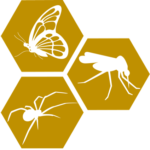Lab 2: DNA Extraction
Goal:
To introduce students to DNA extraction techniques and to isolate genomic DNA from arthropods and Wolbachia, the endosymbiotic bacteria that live within the cells of about half of all arthropod species.
Learning Objectives:
Students will isolate total genomic DNA from arthropods identified in Lab 1. Upon completion of this activity, students will understand that DNA is a diagnostic tool to discover unseen microbes, learn how to extra DNA from arthropods, and increase skills in biotechnology.
Prerequisite Skills: Prior practice with micropipettors.
Teaching Time: 90 minutes (2 class periods – optional 45min stopping point)
RECOMMENDED Activity
The Qiagen DNeasy Blood & Tissue Kit uses spin column technology. Students will macerate arthropods in a lysis buffer, precipitate and transfer the DNA to a column, and spin down to collect DNA in the column membrane. Once in the membrane, students will wash/purify the DNA and, finally, rinse DNA into an elution solution. Because there is no pellet, there is less room for human error.
Qiagen DNeasy Blood & Tissue Kit
- Student Guide: DNeasy DNA Extraction (8/21) (.docx / .pdf)
- Quick Reference: Bench Protocol (11/20)
Alternative Protocols
The following protocols have been tested and recommended by Wolbachia Project Partners.
Edward’s Buffer
This is an affordable and highly effective protocol for experienced students. However, there is more room for human error because students must spin down and rinse DNA pellets.
- Teacher Guide: Edward’s Buffer DNA Extraction (03/19)
- Student Guide: Edward’s Buffer DNA Extraction (03/19)
Promega Wizard SV genomic DNA purification system
This is another highly recommended spin column kit. Classes report great success; it requires the creation of a Digestion Solution Master Mix.
- Quick Guide: Promega Wizard SV DNA Extraction (10/20)
FAQs
Q: Are there any special considerations for certain arthropods?
A: Below are reported tips for working with specific arthropods. Please contact us to share more.
- Mosquitoes – To obtain the best results, decapitate mosquitoes prior to DNA extraction. This will improve detection of Wolbachia via PCR (Beckmann and Fallon, 2012).
- Poly polies (pillbugs) – Students often obtain better results when removing the exoskeleton prior to DNA extraction. It is recommended to dissect the soft tissue as the exoskeleton may have PCR inhibitors. Alternatively, you can extract DNA from just the head (which is opposite from the mosquito recommendation).
- Large arthropods (i.e., cockroaches, grasshoppers, etc.) – If your arthropod is smaller than a grain of rice, you may use the entire organism. However, larger samples will not efficiently lyse in the above protocols and students will end up with less (or no) DNA.
- Dead arthropods – Some students prefer to collect dead arthropods. Keep in mind that DNA degrades after death so results may be variable.
- Ticks – Ticks harbor numerous human pathogens. Therefore, use caution and implement proper safety procedures if your class decides to explore ticks. et al., 2015 determined best results when using adult quadrisections with either the Thermo GeneJET Genomic DNA Purification Kit or Qiagen DNeasy Blood & Tissue Kit.
Q: Our DNA extractions, including control insects, didn’t work. What are we doing wrong?
A: The most critical determinant for success seems to be the maceration step at the very beginning of each protocol. Make sure to use microtube pestles designed specifically for 1.5 ml tubes. Students should thoroughly grind the tissue – if they grind correctly and use muscle strength they will feel it in their hands and arms.
Q: The manufacturer’s protocol recommends a 3-hour incubation, but this protocol says at least 15 minutes. Why is it so much shorter?
A: We tested 15-30 minute incubation periods using Qiagen DNeasy to make it suitable for one class period. Based on our in-class experience, this is sufficient to lyse most samples. However, the longer you incubate the better.
Q: Can I increase the incubation temperature to speed up lysis?
A: The protocols are often optimized for specific kit components. If the protocol involves Proteinase K, for example, higher temperatures will inactivate the enzyme. Therefore, we recommend contacting the manufacturer before making changes to the protocol.
